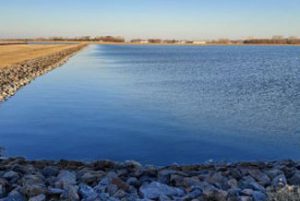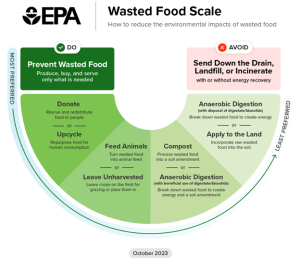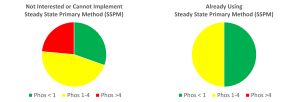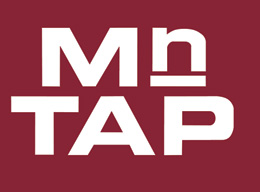March 2024
Inside the Newsletter:
Wastewater Ponds | Wasted Food Scale | Hiring | Prescription Drug
Better Nutrient Treatment for Wastewater Ponds
 The Minnesota Technical Assistance Program (MnTAP), in partnership with the Minnesota Rural Water Association (MRWA) and the Minnesota Pollution Control Agency (MPCA) have developed a new wastewater pond operating strategy coined the Steady State Primary Method (SSPM) which achieves improved treatment for nitrogen and phosphorus. Over the past two years, this project team has been sharing the SSPM through site assessments with roughly ten pond operators each month to encourage implementation resulting in cleaner water. Below is a figure which shows the difference in phosphorus treatment between baseline Minnesota pond systems and the systems that have implemented the Steady State Primary Method.
The Minnesota Technical Assistance Program (MnTAP), in partnership with the Minnesota Rural Water Association (MRWA) and the Minnesota Pollution Control Agency (MPCA) have developed a new wastewater pond operating strategy coined the Steady State Primary Method (SSPM) which achieves improved treatment for nitrogen and phosphorus. Over the past two years, this project team has been sharing the SSPM through site assessments with roughly ten pond operators each month to encourage implementation resulting in cleaner water. Below is a figure which shows the difference in phosphorus treatment between baseline Minnesota pond systems and the systems that have implemented the Steady State Primary Method.
This treatment method is relatively easy to implement and incorporates a pond operational best practice of creating old water. The following is an explanation of the steady state primary system for a standard three-pond system with pond operating depths of 6’. Starting from having mostly full ponds ready for discharge, the strategy involves:
- Discharge pond 3 as per usual.
- Transfer water from pond 2 to fill pond 3.
- Set the pond 1 slide gate at 6’
- This should result in a mostly full pond 1, with new incoming water pushing treated water over the pond 1 slide gate to slowly fill pond 2.
- As pond 2 is nearly full, repeat this process.
This strategy results in ponds 1 and 3 being full, with pond 2 slowly filling with water treated in pond 1 for the majority of pond operation. This ensures the system has high hydraulic retention time and is theorized to create a relatively consistent microbial population in pond 1 which is being fed a consistent source of influent wastewater. It also maximizes retention times in pond 3, which increases the likelihood of growth of the aquatic plant ‘coontail’ which is known to be particularly useful at capturing nutrient pollution.
This project is scheduled to run through June 30, 2024, so please reach out to Jon Vanyo (jvanyo@umn.edu) if you would like to discuss pond operational strategies or how the Steady State Primary Method may be able to help your town achieve better nutrient treatment and cleaner water.
This project is funded through a grant from the Legislative Citizens Commission on Minnesota Resources (LCCMR).
Wasted Food Scale
 The EPA recently released a new Wasted Food Scale (Scale) to supplant the EPA Food Recovery Hierarchy from the 1990s. The below image shows the Scale, and demonstrates the various pathways that are available to handle wasted food. There is a distinction in the name of the title, wasted food. This differs from the more ubiquitous phrase, food waste. The reason is wasted food signifies the inherent value of food, and thus, it shouldn’t be wasted. It puts emphasis on the fact that we all have an active role to play in making sure that food doesn’t get wasted.
The EPA recently released a new Wasted Food Scale (Scale) to supplant the EPA Food Recovery Hierarchy from the 1990s. The below image shows the Scale, and demonstrates the various pathways that are available to handle wasted food. There is a distinction in the name of the title, wasted food. This differs from the more ubiquitous phrase, food waste. The reason is wasted food signifies the inherent value of food, and thus, it shouldn’t be wasted. It puts emphasis on the fact that we all have an active role to play in making sure that food doesn’t get wasted.
A few key highlights of the Scale include:
- Various pathways are coupled together in an “or” scenario where two strategies sit in parallel with each other (compost and anaerobic digestion with beneficial use of digestate). The EPA determined some pathways are relatively similar in performance from an environmental standpoint and thus coupled them together.
- Upcycle as a distinct pathway to handle wasted food. Upcycling entails utilizing various techniques to add value to a wasted food item and help it achieve its highest and best use. Upcycling pathways for wasted food can include human treats, animal treats, textiles, and built environment products. See the Upcycled Food Association for more information.
- Background data is needed to support the placement of different strategies on the Scale. In particular, the report offers a robust look at 11 common pathways to handle wasted food, and what the impacts of each pathway are.
- Soil amendments are important. Soil amendments include compost and digestate from anaerobic digestion. Soils are starving worldwide, and compost in particular has a big role to play in restoring soil structure and health, and helping regenerate soils with nitrogen and carbon. This allows lands to be more productive and support more ecological activity.
- Leaving land unharvested has some value. This is especially important if the crop won’t sell at market. Ideally, an unharvested plot would lead to less planting the following year. In other words, supply would shift to meet demand.
MnTAP strives to continuously encourage clients to move from right to left on the Scale, or from least preferred strategy to most preferred. Source reduction, reuse, upcycling, and animal feed feature prominently in recommendations that we make, and upcycling in particular has gotten a bit of attention lately. The University of Minnesota is finalizing an assistant professor hire to focus on bioconversion and upcycling of wasted food. MnTAP currently has a FINNOVATION Lab internship posted for this upcoming summer, and the hired student will use upcycling research conducted by a U of M Life Cycle Assessment (LCA) class to orient themselves to various feedstocks, as well as engage with industry partners and companies.
Donation is equally important as upcycling, and our Second Harvest Heartland (SHH) internship will focus on optimizing food recovery in Minnesota. In addition to donation, MnTAP has recently worked with three separate clients on source reduction recommendations, and is actively involved in composting, anaerobic digestion, and animal feed recommendations for clients. We continue to work toward solutions that are economically viable and environmentally beneficial.
Highlighting source reduction as the most preferred solution, April 1-7 was National Food Waste Prevention Week. According to a county food waste specialist, “More than 500 public and private organizations raised awareness and inspired a call to action to reduce uneaten food in our homes, workplaces, and communities. Nearly 40 percent of food in the U.S. is thrown away – wasting all of the resources that went into creating it. Loss and waste occur at each stage of the food supply chain, with the majority happening at consumer-facing businesses – such as grocery stores and restaurants – and in homes.” We all have a part to play in reducing food waste. Eat what you have, order what you need, divert what you generate as scraps to compost, and encourage others to do the same.
For More Information, Contact
Jon Schroeder – Waste Materials Specialist
jschro@umn.edu
MnTAP is Hiring: Full-Time Engineer
Are you looking to make a real difference for Minnesota businesses and the environment? MnTAP is seeking an enthusiastic, mission-driven colleague to join our team!
The Minnesota Technical Assistance Program (MnTAP) is an outreach and assistance program at the University of Minnesota that helps Minnesota businesses develop and implement industry tailored solutions that prevent pollution at the source, maximize efficient use of resources, and reduce energy use and cost. This position reports to a MnTAP Senior Engineer and provides engineering technical assistance and support focused on eliminating the cause of pollution or excess resource use at the source for businesses throughout Minnesota. Several important responsibilities of this position include:
- Provide technical assistance for pollution prevention, water conservation and energy efficiency
- Serve as a technical resource for businesses while honing expertise in target industry sectors
- Conduct site visits and coordinate MnTAP interns to deliver technical assistance
- Supervise student intern and manage collaborative partner research projects
- Review and update business resources to promote industrial conservation opportunities
- Conduct technical training and give technical presentations in areas of expertise
If you have ever considered making a change in order to see positive impact from your work, this opportunity could be for you!
Apply Today
The MnTAP and the University of Minnesota recognize and value the importance of diversity and inclusion in enriching the employment experience of its employees and in supporting the academic mission. We are committed to attracting and retaining employees with varying identities and backgrounds. The University of Minnesota provides equal access to and opportunity in its programs, facilities, and employment without regard to race, color, creed, religion, national origin, gender, age, marital status, disability, public assistance status, veteran status, sexual orientation, gender identity, or gender expression.
This position is available under our Research Professional 1 and Research Professional 2, but only one position will be filled. Click the links below to decide which category is right for you:
RP1: https://hr.myu.umn.edu/jobs/ext/360055
RP2: https://hr.myu.umn.edu/jobs/ext/360052
Prescription Drug Take Back Day
Saturday, April 27, 2024
Twice per year, the U.S. Drug Enforcement Administration sponsors a National Prescription Drug Take Back Day in an effort to limit abuse and ensure proper disposal of prescription medication. Proper drug disposal can also prevent pollution, as components of prescription drugs have been detected in surface waters in recent years. If you have expired medication in your possession, don’t just flush it down the drain – protect the environment and those around you by following the guidance on the flyer below.
The next Take Back Day is Saturday, April 27 – you can find more information and a drop-off location near you at www.dea.gov/takebackday.


